
 [REDACTED]
[REDACTED] 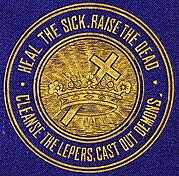

 Examples and symbols of new religious movements: a Sioux Ghost dance, the USVA emblem for the Native American Church, the symbol for Theosophy, the Cross and Crown of Christian Science, a Pentecostal worship service and a statue of the LDS angel Moroni.
Examples and symbols of new religious movements: a Sioux Ghost dance, the USVA emblem for the Native American Church, the symbol for Theosophy, the Cross and Crown of Christian Science, a Pentecostal worship service and a statue of the LDS angel Moroni.
Numerous new religious movements have formed in the United States. A new religious movement (NRM) is a religious or spiritual group that has modern origins and is peripheral to its society's dominant religious culture. There is no single, agreed-upon criterion for defining a "new religious movement".
Prior to the American Civil War, new movements included Mormonism, led by a prophet; Adventism, which used biblical scholarship to predict the Second Coming of Jesus; New Thought, which promised that mental powers could provide health and success; and Spiritualism, which offered communication with ghosts or spirits. By 1900, flourishing movements included the Jehovah's Witnesses, a group that emerged from Bible tract publishing; Theosophy, whose leader claimed to be in telepathic communication with Masters of the Ancient Wisdom; Christian Science, which promised spiritual healing; and Black Hebrew Israelites, built on a revelation that African Americans are descendants of the Biblical Hebrews. The 20th century saw the rise of black nationalism groups like Moorish Science and Nation of Islam; anti-Christian groups like Thelema, a magic-based movement involving sex rituals and worship of the Whore of Babalon; Scientology, a Thelema-inspired movement whose founder reportedly identified himself with the Antichrist; and Satanism, a movement that encompasses both theistic worshipers of Christian villains and individualist atheists who re-appropriate Christian imagery. The 20th century also saw the rise of the explicitly-atheistic Objectivism movement.
New Native American movements in these eras include the Longhouse Religion, Purification movement, the Ghost Dance movement, the Native American Church and the Indian Shaker Church.
Overview

Revivalism influenced such diverse movements as Joseph Smith's Mormonism (1830), William Miller's Adventism (1831) and Parham and Seymour's Pentecostalism (1900). Adventism in turn influenced Charles Taze Russell's Jehovah's Witnesses.
Mesmerism influenced Phineas Parkhurst Quimby's New Thought Movement. One of Quimby's patients, Mary Baker Eddy, later founded her own new religious movement, Christian Science. E. W. Kenyon and the Word of Faith movement synthesized New Thought with Pentecostalism, while Norman Vincent Peale's Power of Positive Thinking incorporated New Thought doctrines into a blend of Methodism and Calvinism. Noble Drew Ali's Moorish Science was influenced by New Thought and in turn influenced Wallace Fard Muhammad's Nation of Islam.
Swedenborgism influenced the Fox Sisters's Spiritualism as well as Joseph Smith's Mormonism. Spiritualism influenced Paschal Beverly Randolph founder of Fraternitas Rosae Crucis, and Helena Blavatsky, the founder of Theosophy. Blavatsky was influenced by the work of Éliphas Lévi. Aleister Crowley and Jack Parsons's Thelema were influenced by Theosophy and Levi. Thelema influenced Anton LaVey's Satanism and L. Ron Hubbard's Scientology.
Ayn Rand's Objectivism, though explicitly atheist, has been studied through the framework of new religious movements.
Antebellum movements
Purification movement

Around 1805, Tenskwatawa, a town drunk, reportedly experienced a stupor so deep that he believed he was dead. According to Tenskwatawa, he visited "the Master of Breath", and was shown heaven with game and honey for those who lived virtuously and traditionally. Tenskwatawa denounced Euro-American settlers, calling them offspring of the Evil Spirit, and led a purification movement that promoted unity among Native Americans.
By 1808, Tenskwatawa and his brother Tecumseh established a village that the Americans called Prophetstown and the movement included thousands of followers. On November 7, 1811, while Tecumseh was away, Tenskwatawa ordered the pre-dawn attack on a U.S. military force that initiated the Battle of Tippecanoe. Tenskwatawa's followers retreated after a two-hour engagement and abandoned Prophetstown, which the military burned to the ground. This event was a catalyst for the War of 1812, as the United States blamed the British for providing financial support and ammunition to the Prophetstown community.
Tecumseh was killed at the Battle of the Thames in 1813, and the resistance movement did not recover and was eventually defeated. Tenskwatawa remained in exile in Canada for nearly a decade. After the 1817 Treaty of Fort Meigs, he returned to the United States in 1824 to assist the U.S. government with the Shawnee removal to reservation land in what is now Kansas. The aging Prophet arrived at Shawnee reservation lands in 1828 and faded into obscurity. Tenskwatawa died in Argentine, Kansas, in 1836.
Latter Day Saint movement
See also: List of denominations in the Latter Day Saint movement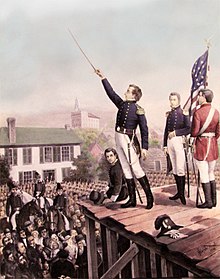
On March 20, 1826, a 20-year-old tenant farmer named Joseph Smith was arrested on charges of being "a disorderly person and an imposter" in Bainbridge, New York. According to court records, Smith said "he had a certain stone which he had occasionally looked at to determine where hidden treasures in the bowels of the earth were; that he professed to tell in this manner where gold mines were a distance under ground".
Starting on September 22, 1827, Smith reported that he had recovered a set of ancient plates and a pair of magical "spectacles". Smith refused to allow anyone to view the plates, though some people were allowed to heft them or feel them through a cloth. On March 26, 1830, Smith published The Book of Mormon, a purported translation of ancient plates, which told the story of Ancient Hebrews who travel to the Americas with the aid of a divinely-provided compass. Thereafter, Smith began directly issuing revelations.
By 1840, Joseph Smith and thousands of followers founded a settlement which Smith named Nauvoo. Smith simultaneously served as Prophet of the church, Mayor of the city, Chief Justice of the Municipal Court, and General of the city's 2,500-man militia (the "Nauvoo Legion"). In 1844, Smith began a campaign to be elected President of the United States, and by April 1844, a Mormon council had declared Smith to be King. On June 18, 1845, Smith declared martial law in Nauvoo and called out the Legion. Smith and his brother were arrested on charges of Treason; both were killed by a mob before being brought to trial.
As of December 2019, the most-populous Latter Day Saint denomination reported having 16 million members worldwide.
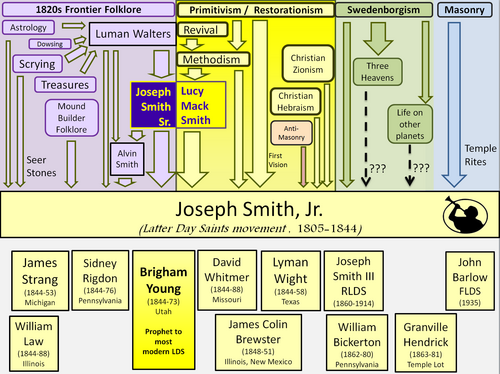
Adventism
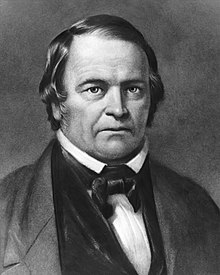
William Miller was a prosperous farmer, a Baptist lay preacher, and student of the Bible living in northeastern New York. In 1832, Miller submitted a series of sixteen articles predicting Christ's return (or "advent") sometime between March 21, 1843, and March 21, 1844. Estimates of Miller's followers—the Millerites—vary between 50,000, and 500,000.
After March 21, 1844, passed without incident, the prediction was revised with a new date of April 18. After that date also passed without Christ's return, Millerites settled upon a third date of October 22. After the failure of Miller's expectations for October 22, 1844, the date became known as the Millerites' Great Disappointment.
Following the Great Disappointment, most Millerites simply gave up their beliefs. Some did not and viewpoints and explanations proliferated. Miller initially seems to have thought that Christ's Second Coming was still going to take place—that "the year of expectation was according to prophecy; but...that there might be an error in Bible chronology, which was of human origin, that could throw the date off somewhat and account for the discrepancy." Miller never gave up his belief in the Second Coming of Christ.
Miller's legacy includes the Seventh-day Adventist Church with over 19 million members and the Advent Christian Church with 61,000 members.
New Thought
See also: List of New Thought denominations and independent centers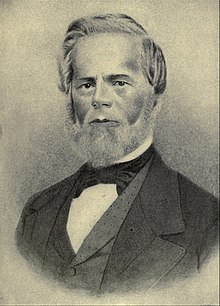
In 1838, Phineas Parkhurst Quimby attended a lecture about Mesmerism by French mesmerist Charles Poyen. Quimby followed Poyen's tour for the next two years, studying Mesmerism. During this time, Quimby encountered an uneducated youth who was particularly susceptible to Mesmerism and developed a tour of his own, demonstrating Mesmerism in front of large crowds.
Quimby claimed to heal people of ailments that doctors could not cure. Quimby told his patients that disease was caused by false beliefs and that the cure was in the explanation of this. Scholar William James used the "mind-cure movement" to refer to Quimby and his successors. Quimby is commonly seen as the founder of the New Thought movement.
New Thought publishing and educational activities reach approximately 2.5 million people annually. The largest New Thought-oriented denomination is the Japanese Seicho-no-Ie. Other belief systems within the New Thought movement include Christian Science, Religious Science, Jewish Science, Moorish Science, Centers for Spiritual Living and Unity. Past denominations have included Psychiana and Father Divine.
Spiritualism
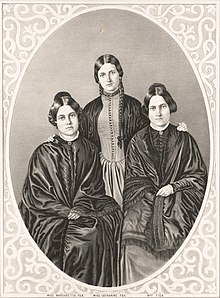
The Fox sisters were three sisters from New York who played an important role in the creation of Spiritualism. The two younger sisters used "rappings" to convince their older sister and others that they were communicating with spirits. Their older sister then took charge of them and managed their careers for some time. They all enjoyed success as mediums for many years.
In 1888, Margaretta confessed that their rappings had been a hoax and publicly demonstrated their method. Margaretta attempted to recant her confession the next year, but their reputation was ruined and in less than five years they were all dead, with Margaretta and Kate dying in abject poverty.
By 1897, Spiritualism was said to have more than eight million followers in the United States and Europe, mostly drawn from the middle and upper classes. Spiritualism flourished for a half century without canonical texts or formal organization, attaining cohesion through periodicals, tours by trance lecturers, camp meetings, and the missionary activities of accomplished mediums. Many prominent spiritualists were women, and like most spiritualists, supported causes such as the abolition of slavery and women's suffrage. Spiritualism is currently practiced primarily through various denominational spiritualist churches in the United States, Canada and the United Kingdom.
Fraternitas Rosae Crucis
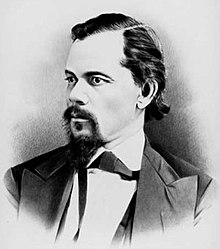
The Fraternitas Rosae Crucis (Latin for Brothers of the Rosy Cross) was founded by Paschal Beverly Randolph in 1858. Their first lodge was established in San Francisco in 1861, and it remains the oldest Rosicrucian organization in the United States, dating back to the era of the American Civil War. Randolph had long used the pseudonym "The Rosicrucian" for his Spiritualist and occult writings. Though Randolph had an interest in sex magic, it is not practiced by the Fraternitas Rosae Crucis. His magico-sexual theories and techniques formed the basis of much of the teachings of another occult fraternity, the Hermetic Brotherhood of Luxor.
Randolph grew up in New York City, a great-nephew of John Randolph of Roanoke and of mixed English, French, German, Native American and Malagasy ancestry on his mother's side. By his mid-twenties, Randolph regularly appeared on stage as a trance medium and advertised his services as a spiritual practitioner in magazines associated with Spiritualism. Like many Spiritualists of his era, he lectured in favor of the abolition of slavery; after emancipation, he taught literacy to freed slaves in New Orleans.
In addition to his work as a trance medium, Randolph trained as a doctor of medicine and wrote and published both fictional and instructive books based on his theories of health, sexuality, Spiritualism and occultism. He wrote more than fifty works on magic and medicine, established an independent publishing company, and was an avid promoter of birth control during a time when it was largely against the law to mention this topic.
Gilded Age movements
During the Gilded Age, the United States saw the rise of movements such as Theosophy, Christian Science, and Jehovah's Witnesses.
Theosophy
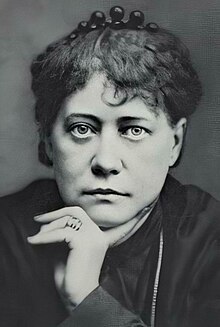
In 1873, Russian immigrant Helena Blavatsky came to the United States and became involved in the Spiritualist movement, rising to public attention as a spirit medium. Blavatsky claimed to have encountered a group of spiritual adepts, the "Masters of the Ancient Wisdom", who sent her to Shigatse, Tibet, where they trained her to develop a deeper understanding of the synthesis of religion, philosophy, and science. Both contemporary critics and later biographers have argued that some or all of these foreign visits were fictitious, and that she spent this period in Europe.
In 1875 New York City, Blavatsky co-founded the Theosophical Society, Blavatsky described Theosophy as "the synthesis of science, religion and philosophy", proclaiming that it was reviving an "Ancient Wisdom" which underlay all the world's religions. In 1877, she published Isis Unveiled, a book outlining her worldview. Associating it closely with the esoteric doctrines of Hermeticism and Neoplatonism, In 1880, she and Olcott moved to India, where the Society was allied to the Arya Samaj, a Hindu reform movement. That same year, while in Ceylon, she and Olcott became the first people from the United States to formally convert to Buddhism. Although opposed by the British colonial administration, Theosophy spread rapidly in India but experienced internal problems after Blavatsky was accused of producing fraudulent paranormal phenomena. Amid ailing health, in 1885 she returned to Europe, there establishing the Blavatsky Lodge in London. Here she published The Secret Doctrine, a commentary on what she claimed were ancient Tibetan manuscripts, as well as two further books, The Key to Theosophy and The Voice of the Silence. She died of influenza.
Christian Science
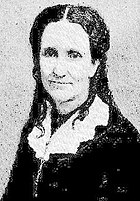
In October 1862, Mary Baker Eddy became a patient of New Thought founder Phineas Quimby. From 1862 to 1865, Quimby and Eddy engaged in lengthy discussions about healing methods practiced by Quimby and others. Eddy gave Quimby much credit for his hypnotic treatments of her nervous and physical conditions and initially thought his brand of Mesmerism entirely benign.
Eddy served a Spiritualist medium. Between 1866 and 1870, Eddy boarded at the home of Brene Paine Clark who was interested in Spiritualism. Seances were often conducted there. In one of her spiritualist trances, Eddy gave a message that was supportive of Phineas Parkhurst Quimby, stating "P. Quimby of Portland has the spiritual truth of diseases. You must imbibe it to be healed. Go to him again and lean on no material or spiritual medium."

In 1868, Eddy first advertised services as a healer in the Spiritualist paper The Banner of Light. During these years, Eddy carried a copy of one of Quimby's manuscripts giving an abstract of his philosophy. Eddy was reportedly still attending séances as late as 1872. In these later séances, Eddy would attempt to convert her audience into accepting Christian Science.
In 1875, Eddy self-published Science and Health, which she called the textbook of Christian Science. Eddy reported teaching at least 800 people. Science and Health contained testimonies of people who claimed to have been healed by reading her teachings. Eddy showed extensive familiarity with Spiritualist practice but denounced it in her Christian Science writings. Historian Ann Braude observed Eddy broke with Spiritualism in her assert that spirit manifestations had never really had bodies to begin with, because matter is unreal and that all that really exists is spirit, before and after death.
In 1879, Eddy founded The Church of Christ, Scientist. At the height of the religion's popularity in 1936, a census counted c. 268,915 Christian Scientists in the United States (2,098 per million). There were an estimated 106,000 Christian Scientists in the United States in 1990 (427 per million). In 2009 the church said that for the first time more new members had been admitted from Africa than from the United States, although it offered no numbers.
Jehovah's Witnesses

About 1870, Charles Taze Russell and his father established a group with a number of acquaintances to undertake an analytical study of the Bible and the origins of Christian doctrine, creed, and tradition. The group, strongly influenced by the writings of Millerite Adventist ministers George Storrs and George Stetson, who were also frequent attendees, concluded that many of the primary doctrines of the established churches, including the Trinity, hellfire, and inherent immortality of the soul, were not substantiated by the scriptures.
Around January 1876 Russell received a copy of Nelson Barbour's Herald of the Morning in the mail. Barbour was an influential Adventist writer and publisher. Russell telegraphed Barbour to set up a meeting. Barbour and John Henry Paton visited Allegheny in March 1876 at Russell's expense so that he could hear their arguments, and compare the conclusions that each side had made in their studies. Russell sponsored a speech by Barbour in St. George's Hall, Philadelphia in August 1876 and attended other lectures by Barbour.
Among the teachings Barbour introduced was the view that Christians who had died would be raised in April 1878. Russell, who had previously rejected prophetic chronology, was moved to devote his life to what he was convinced were now the last two years before the invisible, spiritual return of Christ. He sold his five clothing stores for approximately $300,000 (current value $8,584,000). With Russell's encouragement and financial backing, Barbour wrote an outline of their views in Three Worlds and the Harvest of This World, published in 1877. A text Russell had previously written, titled The Object and Manner of our Lord's Return, was published concurrently through the offices of the Herald of the Morning. Russell was eager to lead a Christian revival and called two separate meetings of Christian leaders in Pittsburgh. Russell's ideas, particularly stressing the imminence of the rapture and the second advent of Christ, were rejected both times. When 1878 arrived, failure of the expected rapture brought great disappointment for Barbour and Russell, and their associates and readers.
Russell withdrew his financial support and started his own journal, Zion's Watch Tower and Herald of Christ's Presence, publishing his first issue in July 1879. Barbour formed The Church of the Strangers that same year, continuing to publish Herald of the Morning. In 1881, Russell founded Zion's Watch Tower Tract Society, with William Henry Conley as president and Russell as secretary-treasurer; they intended to disseminate tracts, papers, doctrinal treatises and Bibles. All materials were printed and bound by Russell's privately owned Tower Publishing Company for an agreed price, then distributed by colporteurs. The Society was incorporated in 1884, with Russell as president, and in 1886 its name was changed to Watch Tower Bible and Tract Society.
Ghost Dance movement

Wovoka claimed to have had a prophetic vision after falling into a coma (possibly due to scarlet fever) during the solar eclipse of January 1, 1889. Wovoka's vision entailed the resurrection of the Paiute dead, and the removal of whites and their works from North America. Wovoka taught that in order to bring this vision to pass, the Native Americans must live righteously and perform a traditional round dance, known as the Ghost Dance.
Wovoka's prophetic message referenced a number of Christian theological concepts. In the "Messiah Letters", Wovoka spoke of Jesus Christ's life on Earth and likened the foretold redemption of Native Americans to a biblical Judgement Day. Wovoka made references to the reunion of the living and the dead, and also advocated for non-violence in the Christian spirit of pacifism and fair temperament. In its imagery and symbolism, the Ghost Dance embodied many of these Christian principles.
Anthropologists, historians, and theologians provide conflicting accounts on when and how Wovoka had his vision. One scholar of religions, Tom Thatcher, cites James Mooney's Smithsonian-sponsored anthropological report to claim that Wovoka received his first vision while chopping wood for David Wilson in 1887. Conversely, historian Paul Bailey utilized Mooney's work along with interviews with Wovoka's contemporaries and interpreters to assert that he received the vision after entering a two-day trance, awaking in tears. Regardless, shortly after receiving the vision and its message, it moved quickly beyond his local Paiute community by word of mouth to Native American tribes further east, notably the Lakota.
The Ghost Dance movement is known for being practiced by the victims of the Wounded Knee Massacre. Before the Ghost dance reached Native Americans on South Dakota plains reservations, interest in the movement came from the U.S. Indian Office, U.S. War Department, and multiple Native American tribal delegations. As the movement spread across the American west, various interpretations of Wovoka's original message were adopted, notably by the Lakota Sioux living on the Pine Ridge reservation. The Lakota interpretation was considered more militant, placing additional emphasis on the foretold elimination of White men. Although the Lakota interpretation promoted hostility toward US federal agents, it did not explicitly advocate for violent action. Historical evidence suggests that the unconventional practice of Christianity on the part of the Lakota tribe was largely responsible for the tensions between Whites and Native Americans leading up to the Battle at Wounded Knee. US authorities challenged the theological views of the Ghost Dance movement, and arguably sought conflict with the Lakota tribe as a means of condemning these practices. Wovoka never left his home in Nevada to become an active participant in the dance's dissemination in the U.S. interior.
Indian Agents, soldiers, and other federal officials tended to have a hostile and sometimes violent attitude toward the movement.
Wovoka was disheartened by how events unfolded at the massacre. He still remained a prominent Native American leader until his death. Sometime between 1894 and 1896, he was reported to have been a sideshow attraction at a San Francisco Midwinter Fair Carnival. In 1917, an agent for the Nevada Agency named L.A. Dorrington tracked down Wovoka to report on his whereabouts to Washington. Curious to see if the former Native American messiah had any ties to the Native American Church, Dorrington found that Wovoka was instead living a humble life in Mason. He abstained from the practice, worked as an occasional medicine man, and traveled to events on reservations across the United States.
Wovoka died in Yerington on September 20, 1932, and is interred in the Paiute Cemetery in the town of Schurz, Nevada.
20th-century movements
The 20th century saw the rise of such movements as Pentecostalism, Moorish Science, Nation of Islam, Positive Thinking, Scientology and Satanism.
Pentecostalism

Charles Fox Parham started Bethel Bible College at Topeka in October 1900. The school was modeled on Sandford's "Holy Ghost and Us Bible School", and Parham continued to operate on a faith basis, charging no tuition. He invited "all ministers and Christians who were willing to forsake all, sell what they had, give it away, and enter the school for study and prayer". About 40 people (including dependents) responded. The only textbook was the Bible, and the teacher was the Holy Spirit (with Parham as a mouthpiece).
Prior to starting his Bible school, Parham had heard of at least one individual in Sandford's work who spoke in tongues and had reprinted the incident in his paper. He had also come to the conclusion that there was more to a full baptism than others acknowledged at the time. By the end of 1900, Parham had led his students at Bethel Bible School through his understanding that there had to be a further experience with God, but had not specifically pointed them to speaking in tongues. While Parham's account indicates that when classes were finished at the end of December, he left his students for a few days, asking them to study the Bible to determine what evidence was present when the early church received the Holy Spirit, this is not clear from the other accounts. The students had several days of prayer and worship, and held a New Year's Eve watchnight service at Bethel (December 31, 1900). The next evening (January 1, 1901) they also held a worship service, and it was that evening that Agnes Ozman felt impressed to ask to be prayed for to receive the fullness of the Holy Spirit. Immediately after being prayed for, she began to speak in what they referred to as "in tongues", speaking in what was believed to be a known language.
Azusa Street Revival

In 1905, William J. Seymour, the one-eyed 34-year-old son of freed slaves, was a student of well-known Pentecostal preacher Charles Parham and an interim pastor for a small holiness church in Topeka, Kansas.
In 1906, Seymour moved to Los Angeles, California, where he preached the Pentecostal message and sparked the Azusa Street Revival. The revival drew large crowds of believers as well as media coverage that focused on the controversial religious practices as well as the racially integrated worship services, which violated the racial norms of the time. Seymour's leadership of the revival and publication of The Apostolic Faith newspaper launched him into prominence within the young Pentecostal movement. Seymour broke with Parham in 1906 over theological differences as well as Parham's unhappiness with interracial revival meetings.
As the revival's influence extended beyond Los Angeles through evangelism and missionary work, Seymour was in the process of developing the revival into a larger organization called the Apostolic Faith Movement. This process was ultimately defeated by power struggles with other ministers, such as Florence Crawford and William Howard Durham, which ultimately damaged the unity of the early Pentecostal movement and led to a decrease in Seymour's influence. By 1914, the revival was past its peak, but Seymour continued to pastor the Apostolic Faith Mission he founded until his death. The revival acted as a catalyst for the spread of Pentecostal practices, such as speaking in tongues and integrated worship, throughout the world. It also played an important role in the history of most major Pentecostal denominations.
Moorish Science

In 1913 Noble Drew Ali founded the Canaanite Temple in Newark, New Jersey, before relocating to Chicago, where he gained a following of thousands of converts.
Drew Ali taught that African Americans were all Moors, who he claimed were descended from the ancient Moabites (describing them as belonging to Northwest Africa as opposed to Moab as the name suggests). He claimed that Islam and its teachings are more beneficial to their earthly salvation, and that their 'true nature' had been 'withheld' from them. Male members of the Temple wear a fez or turban as head covering; women wear a turban.
As Drew Ali began urging the "Moorish-Americans" to become better citizens, he made speeches like, "A Divine Warning By the Prophet for the Nations", in which he urged them to reject derogatory labels, such as "Black", "colored", and "Negro". He urged Americans of all races to reject hate and embrace love. He believed that Chicago would become a second Mecca.
Drew Ali crafted Moorish Science ideology from a variety of sources, a "network of alternative spiritualities that focused on the power of the individual to bring about personal transformation through mystical knowledge of the divine within". In the interwar period in Chicago and other major cities, he used these concepts to preach Moorish pride. His approach appealed to thousands of African Americans who had left severely oppressive conditions in the South through the Great Migration and faced struggles adapting in new urban environments.
In early 1929, following a conflict over funds, Claude Green-Bey, the business manager of Chicago Temple No. 1 split from the Moorish Science Temple of America. He declared himself Grand Sheik and took a number of members with him. On March 15, Green-Bey was stabbed to death at the Unity Hall of the Moorish Science Temple, on Indiana Avenue in Chicago.
Drew Ali was out of town at the time, but upon his return to Chicago, Ali was arrested by police on suspicion of having instigated the killing. Shortly after his release by the police, Drew Ali died at age 43 at his home in Chicago on July 20, 1929. Although the exact circumstances of his death are unknown, the Certificate of Death stated that Noble Drew Ali died from "tuberculosis broncho-pneumonia". Despite the official report, many of his followers speculated that his death was caused by injuries from the police or from other members of the faith.
The Nation of Islam

Wallace Fard Muhammad, acting as a door-to-door travelling salesman, spread his religious teachings throughout Detroit, and within three years grew the movement to a reported 8,000-9,000 members in Detroit, Chicago and other cities. Today, the Nation of Islam has an estimated membership of 20,000–50,000.
Fard taught a form of Black exceptionalism and self-pride to poor southern Blacks during the Great Northward Migration at a time when old ideas of scientific racism were prevalent. He advocated community members to establish and own their own businesses, eat healthy, raise families, and refrain from drugs and alcohol. He influenced his successor Elijah Muhammad, Malcolm X and many other black nationalist thinkers. Detractors accuse him of being a con man who used mystery and charisma to swindle poor Blacks by selling them new Muslim names and stirring up racial animosity.
Peale and the Power of Positive Thinking

Norman Vincent Peale's father was a Methodist minister, and in 1922, Peale was himself ordained as a Methodist minister, preaching in his father's church. In 1932, Peale changed his religious affiliation to the Reformed Church in America and began serving as pastor of Marble Collegiate Church in New York City.
In 1952, Peale published his most popular work The Power of Positive Thinking, a spiritual self-help book. Peale has been described as a member of the New Thought movement.
Peale was highly-influential, receiving praise from several presidents (Nixon, Ford, Carter, Reagan, H.W. Bush, Clinton and Trump spoke well of Peale).
Edgar Cayce
Main article: Edgar Cayce
In 1902, Edgar Cayce of Hopkinsville, Kentucky reported his ability to speak had been restored by a local hypnotist. Cayce performed as a medical clairvoyant, purporting to enter a trance to provide medical diagnoses and treatments b of Along with Christianity and early psychology, Cayce incorporated concepts from Blavatksy's Theosophy, including reincarnation theories of Atlantis, and root races. While insisting he was not a spiritualist, Cayce purported to enter a trance where he would provide psychic readings to correspondents.
Scientology

In 1938, pulp fiction author L. Ron Hubbard underwent a dental procedure in which he was administered a gas; during the procedure, he had an experience that he interpreted as a revelatory near-death experience. In August 1945, Hubbard moved into the Pasadena mansion of occultist John "Jack" Whiteside Parsons, follower of the English ceremonial magician Aleister Crowley and leader of a lodge of Crowley's magical order, Ordo Templi Orientis (OTO). Hubbard befriended Parsons and soon became sexually involved with Parsons's 21-year-old girlfriend, Sara "Betty" Northrup. The two men collaborated on the "Babalon Working", a sex magic ritual intended to summon an incarnation of Babalon, the supreme Thelemite Goddess. It was undertaken over several nights in February and March 1946 in order to summon an "elemental" who would participate in further sex magic.
Hubbard received a revelation that Parsons should fund a business partnership, "Allied Enterprises" which called for Hubbard and Sara to buy yachts in Miami and sail them to the West Coast to sell for a profit. Aleister Crowley strongly criticized Parsons's actions, writing: "Suspect Ron playing confidence trick—Jack Parsons weak fool—obvious victim prowling swindlers." Parsons was "shattered" and had to sell his mansion to developers soon afterward. On August 10, 1946, Hubbard married Sara (though he was not yet legally divorced).
In October 1947 he wrote to request psychiatric treatment:
After trying and failing for two years to regain my equilibrium in civil life, I am utterly unable to approach anything like my own competence. My last physician informed me that it might be very helpful if I were to be examined and perhaps treated psychiatrically or even by a psychoanalyst. Toward the end of my service I avoided out of pride any mental examinations, hoping that time would balance a mind which I had every reason to suppose was seriously affected. I cannot account for nor rise above long periods of moroseness and suicidal inclinations, and have newly come to realize that I must first triumph above this before I can hope to rehabilitate myself at all. ... I cannot, myself, afford such treatment.
Would you please help me?
Beginning in June 1948, the nationally syndicated wire service United Press ran a story on an American Legion-sponsored psychiatric ward in Savannah, Georgia which sought to keep mentally-ill war veterans out of jail. That summer, Hubbard was arrested by the San Louis Obispo sheriff on a charge of petty theft for passing a fraudulent check. In late 1948, Hubbard moved to Savannah, where he would later claim to have worked as a volunteer in the psychiatric clinic, where he claimed he "processed an awful lot of Negroes".
In May 1950, Hubbard published Dianetics: The Modern Science of Mental Health, which claimed that the source of all psychological pain, and therefore the cause of mental and physical health problems, was a form of memory known as "engrams". According to Hubbard, individuals could reach a state he named "Clear" in which a person was freed of these engrams. This would be done by talking with an "auditor".
Dianetics was an immediate commercial success and sparked what Martin Gardner calls "a nationwide cult of incredible proportions". Following the prosecution of Hubbard's foundation for teaching medicine without a license and Hubbard's loss of the rights to Dianetics, in 1953 Hubbard rebranded as Scientology, an explicitly religious movement.
After prosecutions in the United States and the United Kingdom, Hubbard largely lived aboard a ship from 1967 to 1975. During that period, Hubbard instigated a massive infiltration of the US government with over 5,000 covert agents involved; upon discovering the plot in 1977, the FBI conducted simultaneous raids of Hubbard's organizations and multiple high-level Scientologists including Hubbard's wife were convicted and imprisoned for their role in the infiltration. Hubbard remained in hiding the rest of his life, ultimately dying in a motorhome near Creston, California on January 24, 1986.
Satanism
Anton Lavey became a local celebrity in San Francisco through his paranormal research and live performances as an organist. He was also a publicly noticeable figure; he drove a coroner's van around town, and he walked his pet black leopard, named Zoltan. LaVey formed a group called the Order of the Trapezoid, which later evolved into the governing body of the Church of Satan. According to Faxneld and Petersen, the Church of Satan represented "the first public, highly visible, and long-lasting organisation which propounded a coherent Satanic discourse".
LaVey began presenting Friday night lectures on the occult and rituals. A member of this circle suggested that he had the basis for a new religion. According to LaVey himself, on Walpurgisnacht, April 30, 1966, he ritualistically shaved his head, allegedly "in the tradition of ancient executioners", declared the founding of the Church of Satan and proclaimed 1966 as "the Year One", Anno Satanas—the first year of the Age of Satan (it was later demonstrated that LaVey in fact shaved his head because he lost a bet and made up the "ancient executioners" story after the fact). LaVey's image has been described as "Mephistophelian", and may have been inspired by an occult-themed episode of the television show The Wild Wild West titled "The Night of the Druid's Blood" which originally aired on March 25, 1966, and starred Don Rickles as the evil magician and Satanic cult leader Asmodeus, whose Mephistophelean persona is virtually identical to that which LaVey adopted one month later.
See also
- Methodism – Denominations of Protestant Christianity
- Jewish Science – Judaic spiritual movement
- Modern paganism – Religions shaped by historical paganism
- UFO religion – Type of religion which includes beliefs about UFOs or extraterrestrial aliens
- Hare Krishna movement – Religious organisationPages displaying short descriptions of redirect targets
- Transcendental Meditation movement – Programs and organizations connected to Transcendental Meditation
- Rajneesh movement – Persons inspired by the Indian mystic Osho
- New religious movement – Religious community or spiritual group of modern origin
- Unification Church of the United States – Religious movement in the United States
References
- Oliver 2012, pp. 5–6.
- "Charles Taze Russell | American religious leader". Encyclopedia Britannica. 2 September 2024.
- Jones, David Wayne; Woodbridge, Russell S. (October 28, 2011). Health, Wealth & Happiness: Has the Prosperity Gospel Overshadowed the Gospel of Christ?. Kregel Publications. ISBN 9780825489693 – via Google Books.
- George, Carol V. R.; Bowler, Kate (March 26, 2019). God's Salesman: Norman Vincent Peale and the Power of Positive Thinking. Oxford University Press. ISBN 978-0-19-091476-9 – via Google Books.
- Hickey, Wakoh Shannon (February 1, 2019). Mind Cure: How Meditation Became Medicine. Oxford University Press. ISBN 978-0-19-086425-5 – via Google Books.
- Hackett, David G. (2003). Religion and American Culture: A Reader. Psychology Press. ISBN 9780415942737.
- Abbott, Karen. ""A Very Common Delusion": Spiritualism and the Fox Sisters". Smithsonian Magazine.
- Brooke, John L. (May 31, 1996). The Refiner's Fire: The Making of Mormon Cosmology, 1644-1844. Cambridge University Press. ISBN 9780521565646 – via Google Books.
- Blavatsky, Helena Petrovna (March 17, 2018). "Madame Blavatsky pays tribute to Éliphas Levi". Philaletheians UK – via Google Books.
- Reitman, Janet (13 June 2011). Inside Scientology: The Story of America's Most Secretive Religion. HarperCollins. ISBN 9780547549231.
- Burns, Jennifer (June 6, 2005). "Goddess of the Market: Ayn Rand and the American Right, 1930-1980". University of California, Berkeley – via Google Books.
- https://books.google.com/books?id=VK0Inb75
- "Biography – TENSKWATAWA – Volume VII (1836-1850) – Dictionary of Canadian Biography". www.biographi.ca. Retrieved 2024-01-09.
- Edmunds, R. David (March 1, 1985). The Shawnee Prophet (Reprint ed.). University of Nebraska Press. ISBN 978-0803267114.
- Vogel 2004, pp. 81.
- Madsen, Gordon A. (Spring 1990), "Joseph Smith's 1826 Trial: The Legal Setting", BYU Studies, 30 (2): , archived from the original on 2013-12-14
- A visitor to Salt Lake City (1873), "The Original Prophet", Fraser's Magazine, 7: 229
- Knight (1833, p. 3); Smith (1853, p. 99).
- Howe (1834, p. 264); Harris (1859, pp. 169–70); Smith (1884).
- Ostling, Richard; Ostling, Joan K. (October 13, 2009). Mormon America - Rev. Ed.: The Power and the Promise. Harper Collins. ISBN 9780061749803 – via Google Books.
- "Military Service Records of LDS Men". Genealogy Gateway. 1995. Retrieved 15 June 2009.
- Firmage, Edwin Brown; Mangrum, Richard Collin (2001). Zion in the courts. University of Illinois: University of Illinois Press. pp. 114 & 115 of 430 pages. ISBN 0-252-06980-3.
- Smith, George Albert (1948). "Arrest of Joseph and Hyrum Smith on a Charge of Treason--False Imprisonment--Elder Taylor's Protest--False Imprisonment". History of the Church of Jesus Christ of Latter-Day Saints / : 1820-1834 (2d ed. rev. ed.). Salt Lake City, Utah: Deseret Book. ISBN 978-0877476887. Retrieved 26 April 2017.
- "2019 Statistical Report for April 2020 Conference". newsroom.churchofjesuschrist.org. 2020-04-04. Retrieved 2023-01-18.
- Vogel 2004, pp. 42–43.
- Vogel 2004, p. 10.
- ^ Quinn 1998.
- Vogel 2004, p. 122.
- Vogel 2004, p. 37.
- Vogel 2004, pp. 4, 191, 319, 415.
- Vogel 2004, pp. 204–205, 238–239.
- Vogel 2004, p. 59.
- Vogel 2004, p. 128.
- Vogel 2004, pp. 198, 271–272, 352, 623.
- Quinn 1998, pp. 83, 109, 188, 224, 303.
- Vogel 2004, p. 44,315.
- Quinn 1998, pp. 14–15, 153, 176, 217–219.
- Bliss 1853, p. 79
- Miller 1845, p. 17
- Miller 1845, p. 19
- Knight 1993, pp. 163–164.
- Snow 1844, p. 20.
- Everett N. Dick, William Miller and the Advent Crisis Berrien Springs: Press, 1994, 27.
- "Miller Farm". Adventist Heritage Ministry. Retrieved December 29, 2017.
- Fuller, 1982, Mesmerism and the American Cure of Souls. Philadelphia: University of Pennsylvania Press
- Dresser, A.G. (1899). The Philosophy of P.P. Quimby. Boston: George H. Ellis Co.
- Goldberg, P. (2010) American Veda: From Emerson and the Beatles to Yoga and Meditation How Indian Spirituality Changed the West. Random House Digital, Inc. p 62.
- "Masaharu Taniguchi." Religious Leaders of America, 2nd ed. Gale Group, 1999. Reproduced in Biography Resource Center. Farmington Hills, Mich.: Gale, 2008.
- Tyson, Philip John; Jones, Dai; Elcock, Jonathan (9 September 2011). Psychology in Social Context: Issues and Debates. John Wiley & Sons. p. 196. ISBN 978-1-4443-9623-2.
- Podmore, Frankk (2011) . Modern Spiritualism: A History and a Criticism. Methuen & Co. p. 188. ISBN 978-1-108-07257-1. OCLC 14776095.
In the autumn of 1888 Mrs. Kane (Margaretta Fox) and Mrs. Jencken (Catherine Fox) made public, and apparently spontaneous, confession, that the raps had been produced by fraudulent means. Mrs. Kane even gave demonstrations before large audiences of the actual manner in which the toe joints had been used at the early seances. Mrs. Jencken, at any rate, if not also Mrs. Kane, afterward recanted her confession.
- Times, New York (29 November 1897). "THREE FORMS OF THOUGHT; M.M. Mangassarian Addresses the Society for Ethical Culture at Carnegie Music Hall". The New York Times: 200.
- Braude, Ann Braude (2001). Radical Spirits: Spiritualism and Women's Rights in Nineteenth-Century America, Second Edition. Indiana University Press. p. 296. ISBN 978-0-253-21502-4.
- Godwin et al., 1995.
- Deveney (1996), p. 378.
- Gill 1998, 131.
- Robert Peel, Mary Baker Eddy: The Years of Discovery, Holt, Rinehart and Winston, 1971, Chapter 6, Sections I, II.
- Peel 1966, 133.
- Gill 1998, 172.
- Cather and Milmine 1909, 64–68, 111–116.
- Dakin, Edwin Franden. (1929). Mrs. Eddy, the Biography of a Virginal Mind. New York: London, C. Scribner's Sons. p. 56
- Frank Podmore, Mesmerism and Christian Science: A Short History of Mental Healing, George W. Jacobs and Company, 1909, 262, 267–268.
- Robert M. Hall (1916). The Modern Siren. New York: Our Hope. p. 27.
- Todd Leonard, Talking to the Other Side: a History of Modern Spiritualism And Mediumship: A Study of the Religion, Science, Philosophy and Mediums that Encompass this American-Made Religion, iUniverse, Inc., 2005, 32-33
- Robert Peel, Mary Baker Eddy, The Years of Authority, Holt, Rinehart and Winston, 1977, 483, n. 104.
- Gill 1998, 324.
- "Christian Science versus Spiritualism". Archived from the original on May 29, 2013.
- Ann Braude, Radical Spirits: Spiritualism and Women's Rights in Nineteenth-Century America, Indiana University Press, 2001, 186.
- Stark 1998, pp. 190–191.
- Dart, John (1986-12-20). "Healing Church Shows Signs It May Be Ailing". Los Angeles Times. Retrieved 2023-01-18.
- "Africa contributes biggest share of new members to Christian Science church". Christian Science Monitor. ISSN 0882-7729. Retrieved 2023-01-18.
- Penton, M. James (1997). Apocalypse Delayed: The Story of Jehovah's Witnesses (2nd ed.). University of Toronto Press. pp. 14–17. ISBN 0-8020-7973-3.
- Herald of the Morning, July 1878 p.5
- Zion's Watch Tower, July 15, 1906, p. 230
- The Bible Student Movement in the Days of CT Russell, 1975, pp A–2
- Jehovah's Witnesses in the Divine Purpose, 1959, pp. 18–19
- Message to Herald of the Morning subscribers, Zion's Watch Tower, July 1, 1879, Supplement
- Rochester Union and Advertiser, October 5, 1895, p. 12
- Zion's Watch Tower, June 1, 1916 p. 171
- 1975 Yearbook of Jehovah's Witnesses, page 42
- ^ Mooney, James (1896). The ghost-dance religion and the Sioux outbreak of 1890. G.P.O. p. 765. ISBN 9780585345642.
- Estreicher, Justin (April 5, 2019). ""The promises they heard He had made": The Ghost Dance, Wounded Knee, and Assimilation through Christian Orthodoxy". Penn History Review. 24.
- Thatcher, Tom (Autumn 1998). "Empty Metaphors and Apocalyptic Rhetoric". Journal of the American Academy of Religion. 66 (3): 549–570. doi:10.1093/jaarel/66.3.549. JSTOR 1466133.
- Bailey, Paul (1957). Wovoka: The Indian Messiah. Los Angeles: Westernlore Press. pp. 79–83. ISBN 9781258823382.
- ^ "Noble Drew Ali | American religious leader". Encyclopedia Britannica. Retrieved 2017-09-17.
- Bailey, Paul (1957). Wovoka: The Indian Messiah. Los Angeles: Westernlore Press. p. 171. ISBN 9781258823382.
- McCann Jr., Frank D. (1966). "The Ghost Dance, Last hope of Western Tribes, Unleashed the Final Tragedy". Montana: The Magazine of Western History. 16 (1): 25–34. JSTOR 4517018.
- Stewart, Omer C. (1977). "Contemporary Document on Wovoka (Jack Wilson_ Prophet of the Ghost Dance in 1890". Ethnohistory. 24 (3): 219–222. doi:10.2307/481696. JSTOR 481696.
- "Wovoka - Paiute Medicine Man & the Ghost Dance". Legends of America. Retrieved 2010-04-15.
- Blumhofer 1993, p. 50.
- ^ Goff, James R. Jr. (1988). Fields White Unto Harvest: Charles F. Parham and the Missionary Origins of Pentecostalism. University of Arkansas Press. ISBN 1-55728-025-8.
- ^ Martin, Larry (2000). The Topeka Outpouring of 1901. Christian Life Books. ISBN 0-9646289-7-X.
- Cloud, David. "Azusa Street Mission". Retrieved May 24, 2007.
- Yusuf Nuruddin (2000). "African-American Muslims and the Question of Identity: Between Traditional Islam, African Heritage, and the American Way". In Hadda, Yvonne Yazbeck; Esposito, John L. (eds.). Muslims on the Americanization Path?. Oxford University Press. p. 223. ISBN 9780198030928. Retrieved 10 April 2018.
Hence it is in the Moorish Science Temple that we encounter fables about the "ancient Moabite kingdom now known as Morocco, which existed in northwest Amexem. which is now known as northwest Africa."
- ^ Paghdiwala, Tasneem (2007-11-15). "The Aging of the Moors". Chicago Reader. Retrieved 2017-09-17.
- "moorish science temple of america los angeles - Google Search". www.google.com.
- ^ Nance, Susan (2002). "Mystery of the Moorish Science Temple: Southern Blacks and American Alternative Spirituality in 1920s Chicago". Religion and American Culture: A Journal of Interpretation. 12 (2): 123–166. doi:10.1525/rac.2002.12.2.123. ISSN 1052-1151. S2CID 144840143.
- Chicago Tribune
- "Drew Ali, "Prophet" of Moorish Cult, Dies Suddenly". Chicago Defender. July 27, 1929. p. 1 – via ProQuest.
- Perkins, p. 186, as well as other less reputable sources. Perkins cites "Standard Certificate of Death No. 22054, Timothy Drew, issued July 25, 1929, Office of Cook County Clerk, Cook County, Illinois". The certificate was filed by Dr. Clarence Payne-El, who was reportedly at Drew Ali's bedside when he died. See also Scopino.
- McCloud, p. 18; Wilson, p. 35. The Chicago Defender, whose news articles had turned critical, said that "it is believed that the ordeal of the trial together with the treatment he received at the hands of police in an effort to obtain true statements are directly responsible for the illness which precipitated his death" (July 27, 1929).
- MacFarquhar, Neil (2007-02-26). "Nation of Islam at a Crossroad as Leader Exits". The New York Times. ISSN 0362-4331. Retrieved 2020-08-10.
- "Nation of Islam resonates in Detroit as it returns home for convention". Detroit Free Press. Retrieved 2020-08-10.
- Dickson, Rebecca (2015-10-05). "The Nation of Islam could be Chicago's savior". TheHill. Retrieved 2020-08-10.
- "False prophet". Salon. 2000-01-06. Retrieved 2020-08-10.
- "For Marianne Williamson and Donald Trump, religion is all about themselves". The Washington Post. August 1, 2019.
- "Positive Thinking: The Norman Vincent Peale Story - Crouse Entertainment Group".
- "'Going Clear': A New Book Delves Into Scientology". NPR.org. January 24, 2013.
- "The History of Excalibur". lermanet.com.
- Miller, p. 113
- Miller, p. 114
- Urban, Hugh B. Magia sexualis: sex, magic, and liberation in modern Western esotericism, p. 137. Berkeley, CA: University of California Press, 2006. ISBN 978-0-520-24776-5
- Pendle, p. 268
- Pendle, p. 269
- Pendle, p. 270
- Hubbard, L. Ron, letter to Veterans Administration, October 15, 1947; quoted in Miller, p. 137
- e.g. The Herald-News (Passaic, New Jersey) 10 Jun 1948, Ventura County Star-Free Press 23 Jun 1948, Spokane Chronicle (Spokane, Washington)29 Sep 1948
- Miller, p. 142
- PDC43
- Gardner, p. 265
- Miller, p. 213
- Kent, Stephen A. "The Creation of 'Religious' Scientology". Religious Studies and Theology 18:2, pp. 97–126. 1999. ISSN 1747-5414
- High Priest, Magus Peter H. Gilmore. "The Magic Circle / Order of the Trapezoid". churchofsatan.com.
- Faxneld & Petersen 2013, p. 81.
- "Anton LaVey Legend and Reality". www.churchofsatan.org. Retrieved 2016-01-02.
- LIFE Magazine, Shana Alexander & Feb 17, 1967, p. 31.
Works cited
- Alexander, Shane (February 17, 1967). "Opinion and Comment: The Feminine Eye: The Ping is the Thing". LIFE magazine.
- Bliss, Sylvester (1853). Memoirs of William Miller. Boston: Joshua V. Himes.
- Faxneld, Per; Petersen, Jesper Aa. (2013). "The Black Pope and the Church of Satan". In Per Faxneld; Jesper Aagaard Petersen (eds.). The Devil's Party: Satanism in Modernity. Oxford: Oxford University Press. pp. 79–82. ISBN 978-0-19-977924-6.
- Harris, Martin (1859), "Mormonism—No. II", Tiffany's Monthly, 5 (4): 163–170.
- Howe, Eber Dudley (1834), Mormonism Unvailed, Painesville, Ohio: Telegraph Press.
- Knight, Joseph Sr. (1833), Jessee, Dean (ed.), "Joseph Knight's Recollection of Early Mormon History" (PDF), BYU Studies, 17 (1) (published 1976): 35.
- Knight, George R. (1993). Millennial Fever and the End of the World: A Study of Millerite Adventism. Pacific Press. ISBN 978-0-8163-1176-7.
- Miller, William (1845). Wm. Miller's Apology and Defence. Boston: Joshua V. Himes.
- Oliver, Paul (2012). New Religious Movements: A Guide for the Perplexed. London; New York: Continuum. ISBN 978-1-4411-0197-6.
- Quinn, D. Michael (1998), Early Mormonism and the Magic World View (2d ed.), Signature Books, ISBN 1-56085-089-2
- Smith, Lucy Mack (1853), Biographical Sketches of Joseph Smith the Prophet, and His Progenitors for Many Generations, Liverpool: S.W. Richards, ISBN 978-1-4254-8383-8.
- Smith, William (1884), "The Old Soldier's Testimony", The Saints' Herald, 34 (39): 643–44.
- Snow, Samuel S. (August 21, 1844), The Advent Herald.
- Stark, Rodney (May 1998). "The rise and fall of Christian science". Journal of Contemporary Religion. 13 (2): 189–214. doi:10.1080/13537909808580830.
- Vogel, Dan (2004). Joseph Smith: The Making of a Prophet. Salt Lake City, UT: Signature Books. ISBN 1-56085-179-1.
| New religious movements in the United States | |
|---|---|
| Antebellum | |
| Gilded Age | |
| 20th century | |